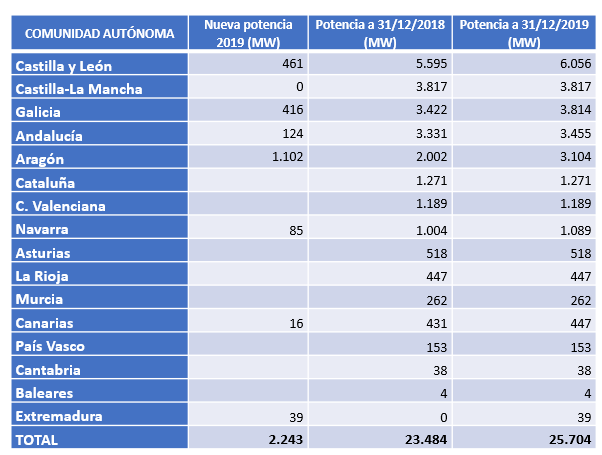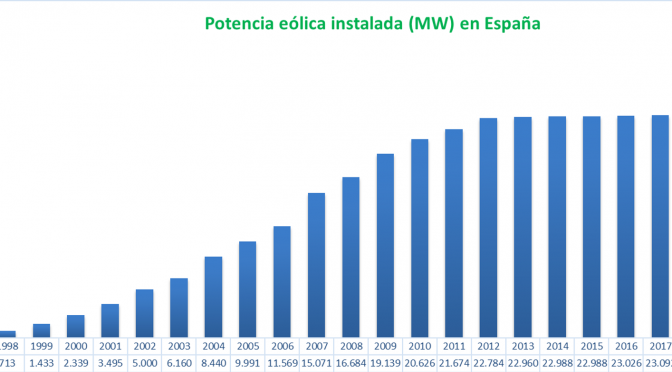Spain leads the ranking of EU countries in onshore wind farm installation. Spain has increased wind power by 2,243 MW in 2019, multiplying by five the installed wind turbines capacity compared to the previous year, adding a total of 25,704 MW of wind power installed with wind turbines. Wind energy has produced 20.8% of the electricity consumed in 2019.
The new wind power installed in 2019 totals 2,243 MW (in 2018 393 MW were installed)
• Spain is the second European country by installed wind power (13% of the EU total), after Germany (30%). 67% of wind power in Europe is concentrated in 5 countries: Germany, Spain, United Kingdom, France and Italy
• Spain is the EU country that has installed more onshore wind turbines in 2019, 15% of the total new power is Spanish
• Wind power contributed 20.8% of the electricity consumed in 2019 (in 2018 it was 19%)

According to data collected by the Spanish Wind Energy Association (AEE), the installed power in Spain of wind energy exceeds 25,700 MW. In 2019, a total of 2,243 MW were installed, which means a total of wind power installed in Spain of 25,704 MW. Compared to 2018, in the past year the installed power has been multiplied by five.
Spain ranks as the first EU country in the ranking of countries with the largest onshore wind power installed during 2019. In total, in the EU and according to WindEurope data, 13.2 GW have been installed between onshore and offshore wind, a 27 % more than the installed capacity in 2018, 78% of this increase corresponds to Spain. Currently, wind energy in Europe produces 15% of the electricity consumed and 67% of installed wind power is concentrated in five countries, with Spain being the second country with the highest wind power.

In our country, wind energy has a presence in virtually all autonomous communities, except for the autonomous community of Madrid, Ceuta and Melilla. During 2019, the autonomous communities that have installed more wind have been Aragón (1,102 MW), followed by Castilla y León (461 MW) and Galicia (416 MW).
In total, there are 1,205 wind farms in Spain, with 20,940 wind turbines installed, which cover 20.8% of electricity consumption. Also, manufacturing centers are present in sixteen of the seventeen autonomous communities.
The 5 wind turbine manufacturers that have installed most of the wind farms are Siemens Gamesa, Vestas, GE, Nordex-Acciona WindPower and Enercon. Among the five manufacturers, they add 98.05% of the installed power.
A new stage of commitment and greater ambition to achieve decarbonization in Spain begins in 2020, where the Energy Transition will be one of the fundamental pillars that will guide the development of our society. From the European perspective, we have as a European objective 35% renewable energy by 2030.
The role of wind energy in the energy transition is main. The wind industry offers clean and cheap generation, and provides additional added value for the set of positive externalities it offers (quality employment, wealth generation in the territory, complete and competitive value chain and technological leadership) and for our international positioning .
“The wind is a strategic part of the productive capital of our country, which guarantees a predictable flow of energy, with a strong industrial manufacturing and R&D presence, which allows the reduction of electricity costs to consumers, creates employment of quality, helps to create economic activity in the regions and reduces our energy dependence ”says Juan Virgilio Márquez, CEO of the Spanish Wind Energy Association.
“To continue with this path of growth for wind power, we hope that the National Integrated Energy and Climate Plan will soon be approved, with ambitious objectives for wind power by 2030. The sector and technology are prepared for it. Likewise, it will be necessary to define and design the tools to guarantee progress at the pace required in the next decade. More specifically, the next Law on Climate Change and Energy Transition is one of those essential tools, as it will guarantee a stable regulatory framework and a political consensus, which will cover the execution of the Integrated National Energy and Climate Plan, and will allow that companies in the sector can establish their business and investment strategies for the next decade. That is why it is so important that the Law be approved with the maximum possible support, ”adds J.V. Marquez.
“In the short term, aspects such as the regulation of access and connection to the network, the modification of auction design, the facilitation of the repowering of existing parks, the mechanisms to guarantee the integration of renewables into the system, the regulation of hybridization and storage, or the progress in the development of offshore wind, are presented as important technical and regulatory challenges, ”says JV Márquez as more immediate and relevant objectives.
/https://www.evwind.com/2020/02/25/la-energia-eolica-supera-los-25-700-mw-instalados-en-espana/


